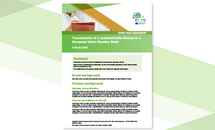Risk Assessment: Risk related to spread of new SARS-CoV-2 variants of concern in the EU/EEA
This risk assessment presents the latest available information on the recent emergence of two variants of potential concern, VOC 202012/01 discovered in the United Kingdom (UK) and another variant, 501.V2 identified in South Africa. It also assesses the risk of these variants of concern being introduced and spread in the EU/EEA, as well as the increased impact this would have on health systems in the coming weeks.
Executive Summary
Viruses constantly change through mutation, and so the emergence of new variants is an expected occurrence and not in itself a cause for concern; SARS-CoV-2 is no exception. A diversification of SARS-CoV-2 due to evolution and adaptation processes has been observed globally.
While most emerging mutations will not have a significant impact on the spread of the virus, some mutations or combinations of mutations may provide the virus with a selective advantage, such as increased transmissibility or the ability to evade the host immune response. In such cases, these variants could increase the risk to human health and are considered to be variants of concern.
New variants of current concern
The United Kingdom (UK) has faced a rapid increase in COVID-19 case rates in the South-East, the East and the London area, which is associated with the emergence of a new SARS-CoV-2 variant, VOC 202012/01. As of 26 December 2020, more than 3 000 cases of this new variant, confirmed by genome sequencing, have been reported from the UK. An increasing proportion of cases in the South East, the East and the London area are due to this variant, but cases have also been identified in other parts of the UK. Although it was first reported in early December, the initial cases were retrospectively identified as having emerged in late September. Preliminary analyses indicate that the new variant has increased transmissibility compared to previously circulating variants, but no increase in infection severity has so far been identified. Since 26 December, a few VOC 202012/01 cases have also been reported in other EU/EEA countries (Belgium, Denmark, Finland, France, Germany, Iceland, Ireland, Italy, the Netherlands, Norway, Portugal, Spain and Sweden) and globally (Australia, Canada, Hong Kong SAR, India, Israel, Japan, Jordan, Lebanon, South Korea, Switzerland, Singapore).
In addition to VOC 202012/01, South Africa has reported another SARS-CoV-2 variant, designated as 501.V2, which is also of potential concern. This variant was first observed in samples from October, and since then more than 300 cases with the 501.V2 variant have been confirmed by whole genome sequencing (WGS) in South Africa, where it is now the dominant form of the virus. Preliminary results indicate that this variant may have an increased transmissibility. However, like the VOC 202012/01, at this stage there is no evidence that 501.V2 is associated with higher severity of infection. On 22 December 2020, two geographically separate cases of this new variant 501.V2 were detected in the UK. Both are contacts of symptomatic individuals returning from travel to South Africa. On 28 December 2020, one additional case of this new variant was detected in Finland in a returning traveller from South Africa.
Risks associated with new variants of current concern
ECDC assesses that the probability of SARS-CoV-2 VOC 202012/01 and 501.V2 being introduced and further spread in the EU/EEA is currently high. Although there is no information that infections with these strains are more severe, due to increased transmissibility the impact of COVID-19 disease in terms of hospitalisations and deaths is assessed as high, particularly for those in older age groups or with co-morbidities. The overall risk associated with the introduction and further spread of SARS-CoV-2 VOC 202012/01 and 501.V2 is therefore assessed as high.
The probability of increased circulation of any SARS-CoV-2 strains and this placing greater pressure on health systems in the coming weeks is considered to be high due to the festive season and, higher still, in countries where the new variants are established. The impact of this increased pressure on health systems is considered to be high even if current public health measures are maintained. Therefore, the overall risk of an increased impact on health systems in the coming weeks is assessed as high.
Maintaining and strengthening non-pharmaceutical interventions
Member States are recommended to continue to advise their citizens of the need for non-pharmaceutical interventions in accordance with their local epidemiological situation and national policies and, in particular, to consider guidance on the avoidance of non-essential travel and social activities.
Options for delaying the introduction of variants of concern
The options available for delaying the introduction and further spread of a new variant of concern are:
- to perform targeted and representative sequencing of community cases to detect early and monitor the incidence of the variant;
- to increase follow-up and testing of people with an epidemiological link to areas with significantly higher incidence of the variant and to sequence samples from such cases;
- to enhance targeted contact tracing and isolation of suspected and confirmed cases of the variant;
- to alert people coming from areas with significantly higher incidence of the variant to the need to comply with quarantine, as well as getting tested and self-isolating if they develop symptoms;
- to recommend avoiding all non-essential travel, in particular to areas with a significantly higher incidence of the variant.
Although in the short-to-medium term the roll-out of vaccinations will probably contribute to the response, these immediate measures are essential until such time as doses are available in sufficient numbers and have been shown to have a mitigating effect.
Increased detection and characterisation
Member States should continue to monitor for abrupt changes in rates of transmission or disease severity as part of the process of identifying and assessing the impact of variants. Data analysis and assessment of the local, regional and national situation should be performed to identify areas with rapidly changing epidemiology.
National public health authorities should notify cases of the new variant, as well as any other new SARS-CoV-2 variants of potential concern, through the Early Warning and Response System (EWRS) and The European Surveillance System (TESSy) for case-based surveillance and aggregate reporting, which has been adapted for this purpose.
In order to be able to detect introductions of known variants, as well as emergence of new variants of concern, Member States need to perform timely genome sequencing of a significant and representative selection of isolates. The UK has demonstrated that their sequencing programme is able to detect emerging variants. Ideally, Member States should aim for a similar timeliness and fraction of samples sequenced, although this will depend on the availability of resources. If representative sequencing on a similar scale to that carried out by the UK is not feasible, samples could be selected where the involvement of a variant of concern is suspected.
Download








